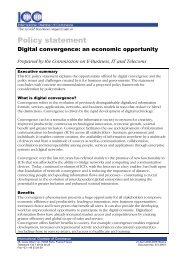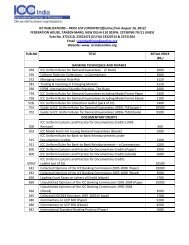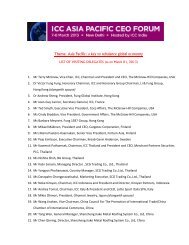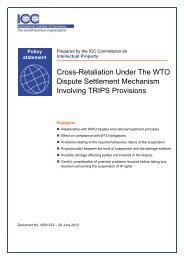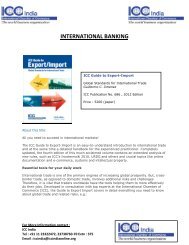2013 - ICC India
2013 - ICC India
2013 - ICC India
- No tags were found...
Create successful ePaper yourself
Turn your PDF publications into a flip-book with our unique Google optimized e-Paper software.
<strong>ICC</strong> BANKING COMMISSION | <strong>2013</strong> GLOBAL RISKS TRADE FINANCE | APPENDIX B 49The impact of EM within the Basel IRB RWA formulae is to increase theRWAs for exposures with longer maturity and to decrease it for those withshorter maturity. In addition, the impact of the EM on RWAs varies with thecustomer’s underlying PD because the expectation is that more capital isrequired to cover downgrades of better-rated customers 89 . As a result, theimpact of maturity is greater for low PD customers, as shown below:FIGURE 30Impact of Maturity on RWA as proportion of RWA for1-year facility 90%1501251007550250Effective MaturityPD = 0.2% PD = 0.2% PD = 0.2% PD = 0.2%Given the impact of maturity and the ability of advanced IRB banks to usea figure of lower than 2.5 years (and in some cases use EM figures belowone year), the EM and short-term nature of many trade finance instrumentsshould therefore, all else being equal, produce lower capital requirementsfor an advanced IRB banks than would be allowed under foundation IRB.ESTIMATION APPROACH AND ASSUMPTIONSGiven the extent of leeway which the IRB approaches afford banks indetermining their own inputs to the RWA formulae, the Basel II text includesa number of additional requirements around the estimation of theseparameters in order to ensure these parameter estimates are appropriate.As noted above, these requirements have been left broadly untouched inBasel 2.5 and Basel III 91 . For each of the parameters used in the IRB RWAfunctions, the requirements have some implications for their estimation ontrade finance transactions. Thus this section aims to describe:■■Some of the requirements for Basel II and III RWA parameter estimation;■■How we have derived the PD, EAD, LGD and maturity parameters fortrade finance instruments based on the Trade Register data;■■■■Some of the adjustments and assumptions which have been required;Indications of potential future enhancements to the analysisAs such, it is aimed at a slightly more technical audience, although it shouldalso be useful for those who want to understand some more of the detailbehind the results in this year’s report.We start by discussing the implications of the Basel II definition of defaultfor PD and LGD estimates.



